Impacts of Spatial Resolution and XCO2 Precision on Satellite Capability for CO2 Plumes Detection
Abstract
1. Introduction
2. Methods
2.1. Simulation Region
2.2. Gaussian Plume Model
2.3. Uncertainties Estimation
3. CO2 Plume Simulation and Analysis
3.1. CO2 Emission from Plant Power
3.2. Detection Capability of Satellite with Different Spatial Resolutions and XCO2 Precisions
3.3. Detection Capability of Satellite under Different Wind Field Conditions
4. Uncertainty Analysis
4.1. Impact of the Uncertainty in Wind Field
4.2. Impact of the Uncertainty in CO2 Emission Level
4.3. Estimation of Overall Uncertainty
5. Summary
- (1)
- Generally, enhanced spatial resolution of satellite, coupled with improved precision in space-based XCO2 measurements will be crucial in accurately detecting and quantifying CO2 emissions from various-sized power plants under diverse meteorological conditions. For low-level emissions (6 Mt CO2/yr), detecting CO2 plumes becomes challenging when the satellite spatial resolution is coarser than 1 km, because of its CO2 enhancement being comparable to satellite observational errors. A reduction in the satellite-retrieved XCO2 precision from 1.5 ppm to 0.7 ppm can significantly enhance the detection capabilities. For high emission levels (25 Mt CO2/yr), the plumes are just observable at pixel sizes of 0.5, 1, and 2 km for εs = 1.5 ppm. However, for εs = 0.7 ppm, power plants with emissions greater than 13 Mt CO2/yr could be detected with a spatial resolution of 4 km or higher.
- (2)
- Wind speed and wind direction significantly impact the detectability of CO2 plumes for satellites. Variations in wind conditions lead to substantial differences in the maximum detectable CO2 enhancement. For a satellite by an εs of 0.7 ppm and a spatial resolution of 2 km, it is capable of differentiating a power plant with an emission of 5.1 Mt CO2/yr from ambient background noise at a wind speed of 4 m/s. Notably, this detection threshold is further improved when the wind speed is reduced to 2 m/s, allowing for the identification of power plants with an emission of 2.69 Mt CO2/yr.
- (3)
- Our results indicate that εw(μ) plays a dominant role in the variation of simulated XCO2 uncertainty introduced by uncertainties in both wind speed and wind direction. With the assumption of a 10% uncertainty in both wind speed and wind direction, for a small-sized power plant (5.1 Mt CO2/yr) under conditions of wind speed increasing from 0.5 m/s to 4 m/s, the εw reduces from 3.75 ± 2.01 ppm to 0.46 ± 0.24 ppm for 1 × 1 km2 pixel size, while it changes from 1.82 ± 0.95 ppm to 0.22 ± 0.11 ppm for 1 × 1 km2. These variations highlight the sensitivity of satellite detection capabilities to meteorological conditions.
- (4)
- The overall uncertainty in satellite-detected XCO2 enhancement was calculated using a combination of uncertainties in wind field, satellite-derived XCO2 error, and CO2 emission levels, considering various εs levels (0.5, 0.7, 1.0, and 1.5 ppm) and 10% uncertainty for obtained wind field and CO2 emission data. The results indicate that ε is significantly influenced by the wind field. Although ε for θ = 45° is larger than that for θ = 270° under the same scenario, satellite has a more effective capability for detecting CO2 emission at θ = 45° due to a more rapid growth of ΔXCO2max. A designed spatial resolution of satellite better than 1 km is suggested, because the CO2 emission from small-sized power plants is much more likely be detected when the wind speed is below 3 m/s.
6. Conclusions
Author Contributions
Funding
Institutional Review Board Statement
Informed Consent Statement
Data Availability Statement
Acknowledgments
Conflicts of Interest
References
- Intergovernmental Panel on Climate Change (IPCC). Summary for Policymakers. In Climate Change 2021—The Physical Science Basis: Working Group I Contribution to the Sixth Assessment Report of the Intergovernmental Panel on Climate Change; Climate Change 2021—The Physical Science Basis; Cambridge University Press: Cambridge, UK, 2023; pp. 3–32. [Google Scholar] [CrossRef]
- UNFCCC. UNFCCC (United Nation Framework Convention on ClimateChange): Decision 18/CMA.1 Modalities, Procedures Andguidelines for the Transparency Framework for Action Andsupport Referred to in Article 13 of the Paris Agreement, FCCC/PA/CMA/2018/Add.2. 2018. Available online: https://unfccc.int/sites/default/files/resource/cma2018_3_add2_new_advance.pdf (accessed on 19 July 2020).
- Janssens-Maenhout, G.; Pinty, B.; Dowell, M.; Zunker, H.; Andersson, E.; Balsamo, G.; Bézy, J.L.; Brunhes, T.; Bösch, H.; Bojkov, B.; et al. Toward an Operational Anthropogenic CO2 Emissions Monitoring and Verification Support Capacity. Bull. Am. Meteorol. Soc. 2020, 101, E1439–E1451. [Google Scholar] [CrossRef]
- Ritchie, H.; Rosado, P.; Roser, M. CO2 and Greenhouse Gas Emissions. Our World Data. 2020. Available online: https://ourworldindata.org/co2-and-greenhouse-gas-emissions (accessed on 1 January 2024).
- Taylor, T.E.; Eldering, A.; Merrelli, A.; Kiel, M.; Somkuti, P.; Cheng, C.; Rosenberg, R.; Fisher, B.; Crisp, D.; Basilio, R.; et al. OCO-3 early mission operations and initial (vEarly) XCO2 and SIF retrievals. Remote Sens. Environ. 2020, 251, 112032. [Google Scholar] [CrossRef]
- Hakkarainen, J.; Szeląg, M.E.; Ialongo, I.; Retscher, C.; Oda, T.; Crisp, D. Analyzing nitrogen oxides to carbon dioxide emission ratios from space: A case study of Matimba Power Station in South Africa. Atmos. Environ. X 2021, 10, 100110. [Google Scholar] [CrossRef]
- Kuhlmann, G.; Henne, S.; Meijer, Y.; Brunner, D. Quantifying CO2 Emissions of Power Plants with CO2 and NO2 Imaging Satellites. Front. Remote Sens. 2021, 2, 689838. [Google Scholar] [CrossRef]
- Liu, L.Y.; Chen, L.F.; Liu, Y.; Yang, D.X.; Zhang, X.Y.; Lu, N.M.; Ju, W.M.; Jiang, F.; Yin, Z.S.; Liu, G.H.; et al. Satellite remote sensing for global stocktaking: Methods, progress and perspectives. Natl. Remote Sens. Bull. 2022, 26, 243–267. [Google Scholar] [CrossRef]
- He, Z.; Lei, L.; Zeng, Z.-C.; Sheng, M.; Welp, L.R. Evidence of Carbon Uptake Associated with Vegetation Greening Trends in Eastern China. Remote Sens. 2020, 12, 718. [Google Scholar] [CrossRef]
- Sheng, M.; Lei, L.; Zeng, Z.-C.; Rao, W.; Song, H.; Wu, C. Global land 1° mapping dataset of XCO2 from satellite observations of GOSAT and OCO-2 from 2009 to 2020. Big Earth Data 2022, 7, 170–190. [Google Scholar] [CrossRef]
- Oda, T.; Feng, L.; Palmer, P.I.; Baker, D.F.; Ott, L.E. Assumptions about prior fossil fuel inventories impact our ability to estimate posterior net CO2 fluxes that are needed for verifying national inventories. Environ. Res. Lett. 2023, 18, 124030. [Google Scholar] [CrossRef]
- Yao, L.; Liu, Y.; Yang, D.; Cai, Z.; Wang, J.; Lin, C.; Lu, N.; Lyu, D.; Tian, L.; Wang, M.; et al. Retrieval of solar-induced chlorophyll fluorescence (SIF) from satellite measurements: Comparison of SIF between TanSat and OCO-2. Atmos. Meas. Tech. 2022, 15, 2125–2137. [Google Scholar] [CrossRef]
- Mousavi, S.M.; Dinan, N.M.; Ansarifard, S.; Sonnentag, O. Analyzing spatio-temporal patterns in atmospheric carbon dioxide concentration across Iran from 2003 to 2020. Atmos. Environ. X 2022, 14, 100163. [Google Scholar] [CrossRef]
- Zheng, B.; Chevallier, F.; Ciais, P.; Broquet, G.; Wang, Y.; Lian, J.; Zhao, Y. Observing carbon dioxide emissions over China’s cities and industrial areas with the Orbiting Carbon Observatory-2. Atmos. Chem. Phys. 2020, 20, 8501–8510. [Google Scholar] [CrossRef]
- Hill, T.; Nassar, R. Pixel Size and Revisit Rate Requirements for Monitoring Power Plant CO2 Emissions from Space. Remote Sens. 2019, 11, 1608. [Google Scholar] [CrossRef]
- Reuter, M.; Buchwitz, M.; Schneising, O.; Krautwurst, S.; O’Dell, C.W.; Richter, A.; Bovensmann, H.; Burrows, J.P. Towards monitoring localized CO2 emissions from space: Co-located regional CO2 and NO2; enhancements observed by the OCO-2 and S5P satellites. Atmos. Chem. Phys. 2019, 19, 9371–9383. [Google Scholar] [CrossRef]
- Kiel, M.; Eldering, A.; Roten, D.D.; Lin, J.C.; Feng, S.; Lei, R.; Lauvaux, T.; Oda, T.; Roehl, C.M.; Blavier, J.-F.; et al. Urban-focused satellite CO2 observations from the Orbiting Carbon Observatory-3: A first look at the Los Angeles megacity. Remote Sens. Environ. 2021, 258, 112314. [Google Scholar] [CrossRef]
- Liu, J.; Bowman, K.W.; Schimel, D.S.; Parazoo, N.C.; Jiang, Z.; Lee, M.; Bloom, A.A.; Wunch, D.; Frankenberg, C.; Sun, Y.; et al. Contrasting carbon cycle responses of the tropical continents to the 2015–2016 El Nino. Science 2017, 358, eaam5690. [Google Scholar] [CrossRef] [PubMed]
- Palmer, P.I.; Feng, L.; Baker, D.; Chevallier, F.; Bosch, H.; Somkuti, P. Net carbon emissions from African biosphere dominate pan-tropical atmospheric CO2 signal. Nat. Commun. 2019, 10, 3344. [Google Scholar] [CrossRef] [PubMed]
- Eldering, A.; Taylor, T.E.; O’Dell, C.W.; Pavlick, R. The OCO-3 mission: Measurement objectives and expected performance based on 1 year of simulated data. Atmos. Meas. Tech. 2019, 12, 2341–2370. [Google Scholar] [CrossRef]
- Mousavi, S.M.; Dinan, N.M.; Ansarifard, S.; Borhani, F.; Ezimand, K.; Naghibi, A. Examining the Role of the Main Terrestrial Factors Won the Seasonal Distribution of Atmospheric Carbon Dioxide Concentration over Iran. J. Indian Soc. Remote Sens. 2023, 51, 865–875. [Google Scholar] [CrossRef]
- Falahatkar, S.; Mousavi, S.M.; Farajzadeh, M. Spatial and temporal distribution of carbon dioxide gas using GOSAT data over IRAN. Environ. Monit. Assess. 2017, 189, 627. [Google Scholar] [CrossRef]
- Golkar, F.; Mousavi, S.M. Variation of XCO2 anomaly patterns in the Middle East from OCO-2 satellite data. Int. J. Digit. Earth 2022, 15, 1219–1235. [Google Scholar] [CrossRef]
- Shim, C.; Han, J.; Henze, D.K.; Yoon, T. Identifying local anthropogenic CO2 emissions with satellite retrievals: A case study in South Korea. Int. J. Remote Sens. 2018, 40, 1011–1029. [Google Scholar] [CrossRef]
- Sierk, B.; Fernandez, V.; Bézy, J.L.; Meijer, Y.; Durand, Y.; Bazalgette Courrèges-Lacoste, G.; Pachot, C.; Löscher, A.; Nett, H.; Minoglou, K.; et al. The Copernicus CO2M mission for monitoring anthropogenic carbon dioxide emissions from space. In Proceedings of the International Conference on Space Optics—ICSO 2020, Online, 30 March–2 April 2021. [Google Scholar]
- Lin, X.; van der A, R.; de Laat, J.; Eskes, H.; Chevallier, F.; Ciais, P.; Deng, Z.; Geng, Y.; Song, X.; Ni, X.; et al. Monitoring and quantifying CO2 emissions of isolated power plants from space. Atmos. Chem. Phys. 2023, 23, 6599–6611. [Google Scholar] [CrossRef]
- Sutton, O.G. A theory of eddy diffusion in the atmosphere. Proc. R. Soc. Lond. Ser. A 1932, 135, 143–165. [Google Scholar]
- Bovensmann, H.; Buchwitz, M.; Burrows, J.P.; Reuter, M.; Krings, T.; Gerilowski, K.; Schneising, O.; Heymann, J.; Tretner, A.; Erzinger, J. A remote sensing technique for global monitoring of power plant CO2 emissions from space and related applications. Atmos. Meas. Tech. 2010, 3, 781–811. [Google Scholar] [CrossRef]
- Pasquill, F. The estimation of the dispersion of windborne material. Meteorol. Mag. 1961, 90, 33–49. [Google Scholar]
- Gan, L.; Lu, T.; Shu, Y. Diffusion and Superposition of Ship Exhaust Gas in Port Area Based on Gaussian Puff Model: A Case Study on Shenzhen Port. J. Mar. Sci. Eng. 2023, 11, 330. [Google Scholar] [CrossRef]
- Hu, Y.; Shi, Y. Estimating CO2 Emissions from Large Scale Coal-Fired Power Plants Using OCO-2 Observations and Emission Inventories. Atmosphere 2021, 12, 811. [Google Scholar] [CrossRef]
- Tong, D.; Zhang, Q.; Davis, S.J.; Liu, F.; Zheng, B.; Geng, G.; Xue, T.; Li, M.; Hong, C.; Lu, Z.; et al. Targeted emission reductions from global super-polluting power plant units. Nat. Sustain. 2018, 1, 59–68. [Google Scholar] [CrossRef]
- Pinty, B.; Janssens-Maenhout, G.; Dowell, M.; Zunker, H.; Brunhes, T.; Ciais, P.; Dee, D.; Denier Van Der Gon, H.; Dolman, H.; Drinkwater, M.; et al. An Operational Anthropogenic CO2 Emissions Monitoring & Verification System: Baseline Requirements, Model Components and Functional Architecture; Publications Office of the European Union: Luxembourg, 2021. [Google Scholar]
- Nassar, R.; Hill, T.G.; McLinden, C.A.; Wunch, D.; Jones, D.B.A.; Crisp, D. Quantifying CO2 Emissions From Individual Power Plants From Space. Geophys. Res. Lett. 2017, 44, 10045–10053. [Google Scholar] [CrossRef]
- Peischl, J.; Ryerson, T.B.; Holloway, J.S.; Parrish, D.D.; Trainer, M.; Frost, G.J.; Aikin, K.C.; Brown, S.S.; Dubé, W.P.; Stark, H.; et al. A top-down analysis of emissions from selected Texas power plants during TexAQS 2000 and 2006. J. Geophys. Res. Atmos. 2010, 115, D16303. [Google Scholar] [CrossRef]
- Angevine, W.M.; Peischl, J.; Crawford, A.; Loughner, C.P.; Pollack, I.B.; Thompson, C.R. Errors in top-down estimates of emissions using a known source. Atmos. Chem. Phys. 2020, 20, 11855–11868. [Google Scholar] [CrossRef]


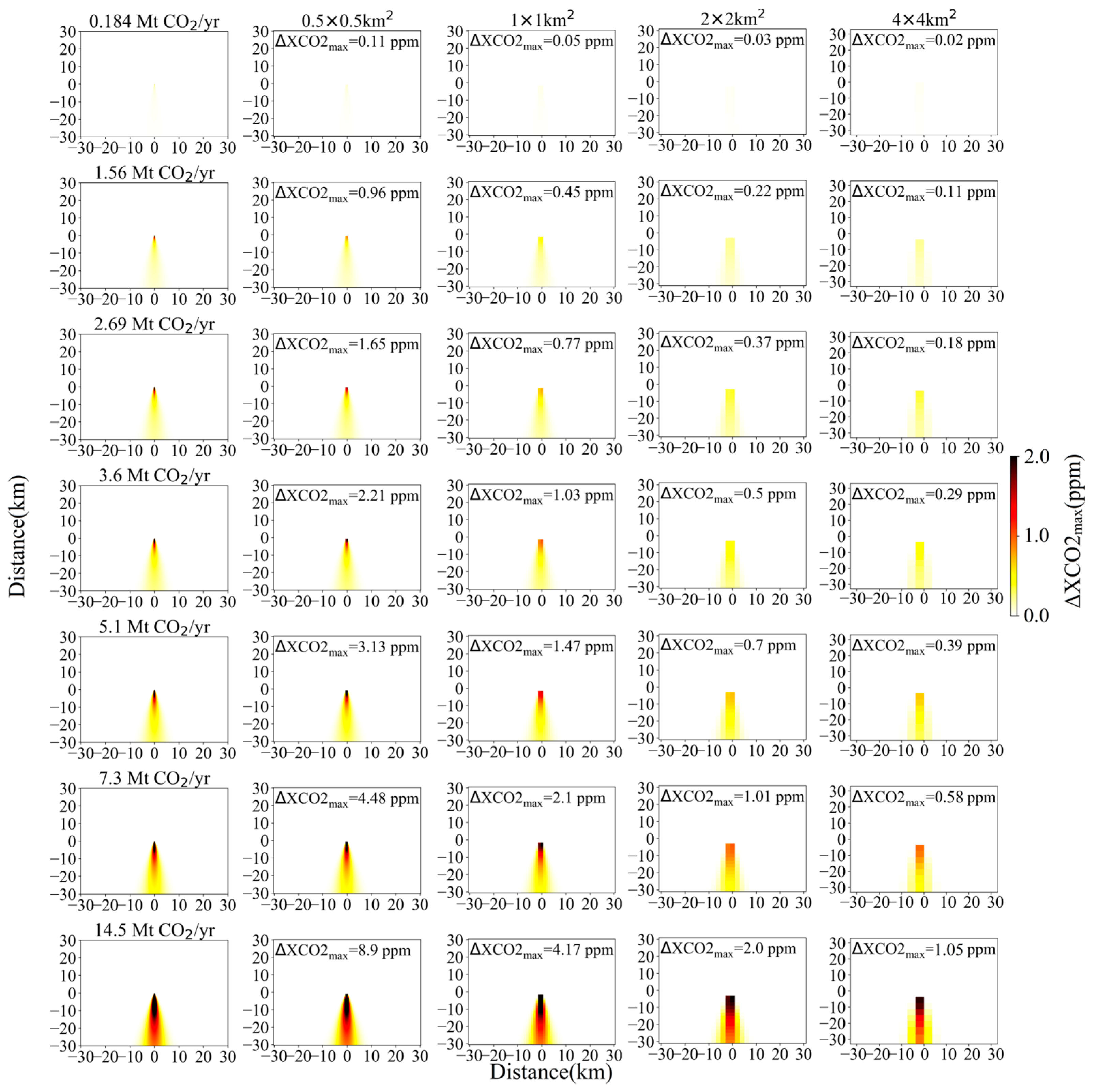
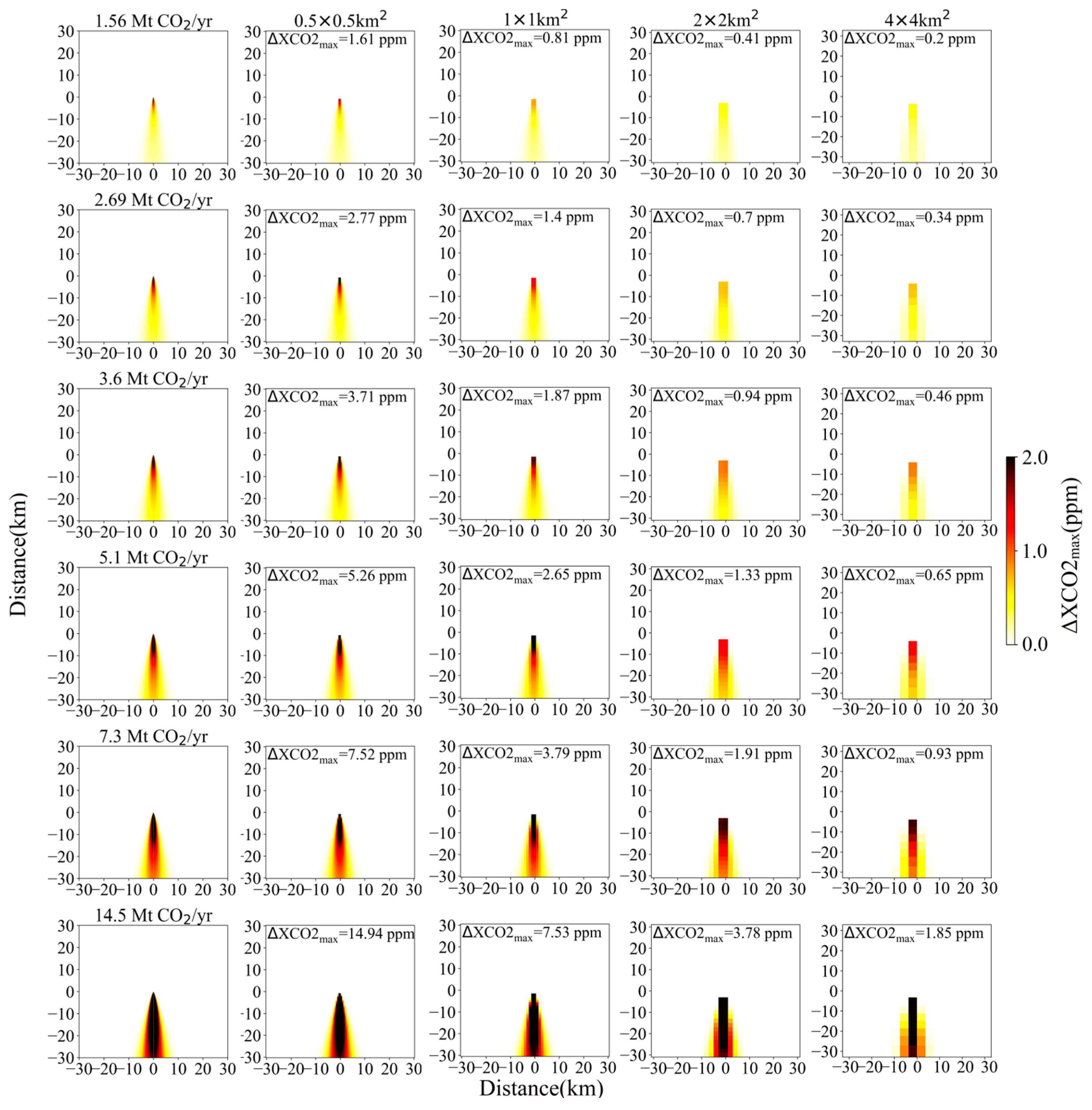



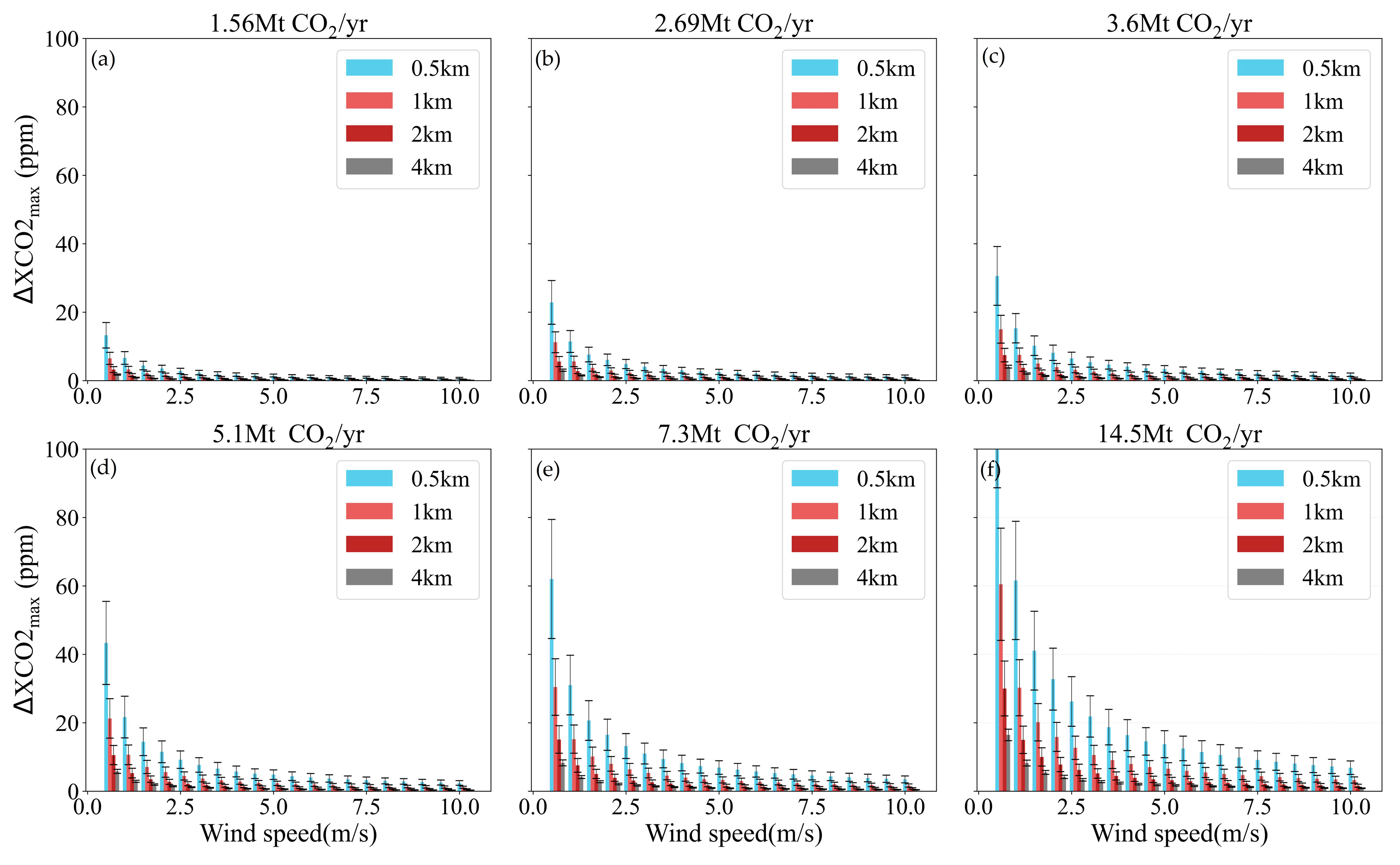

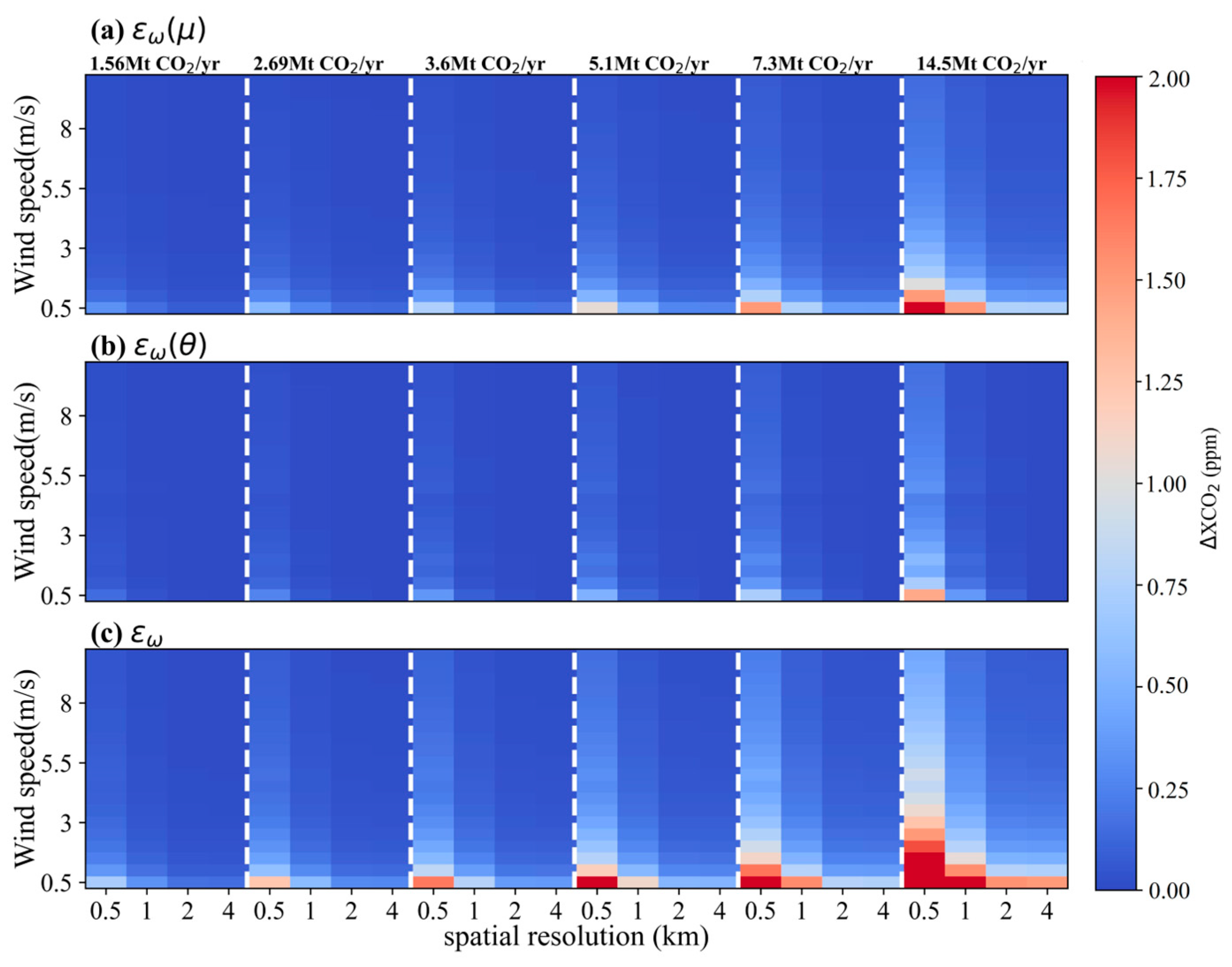

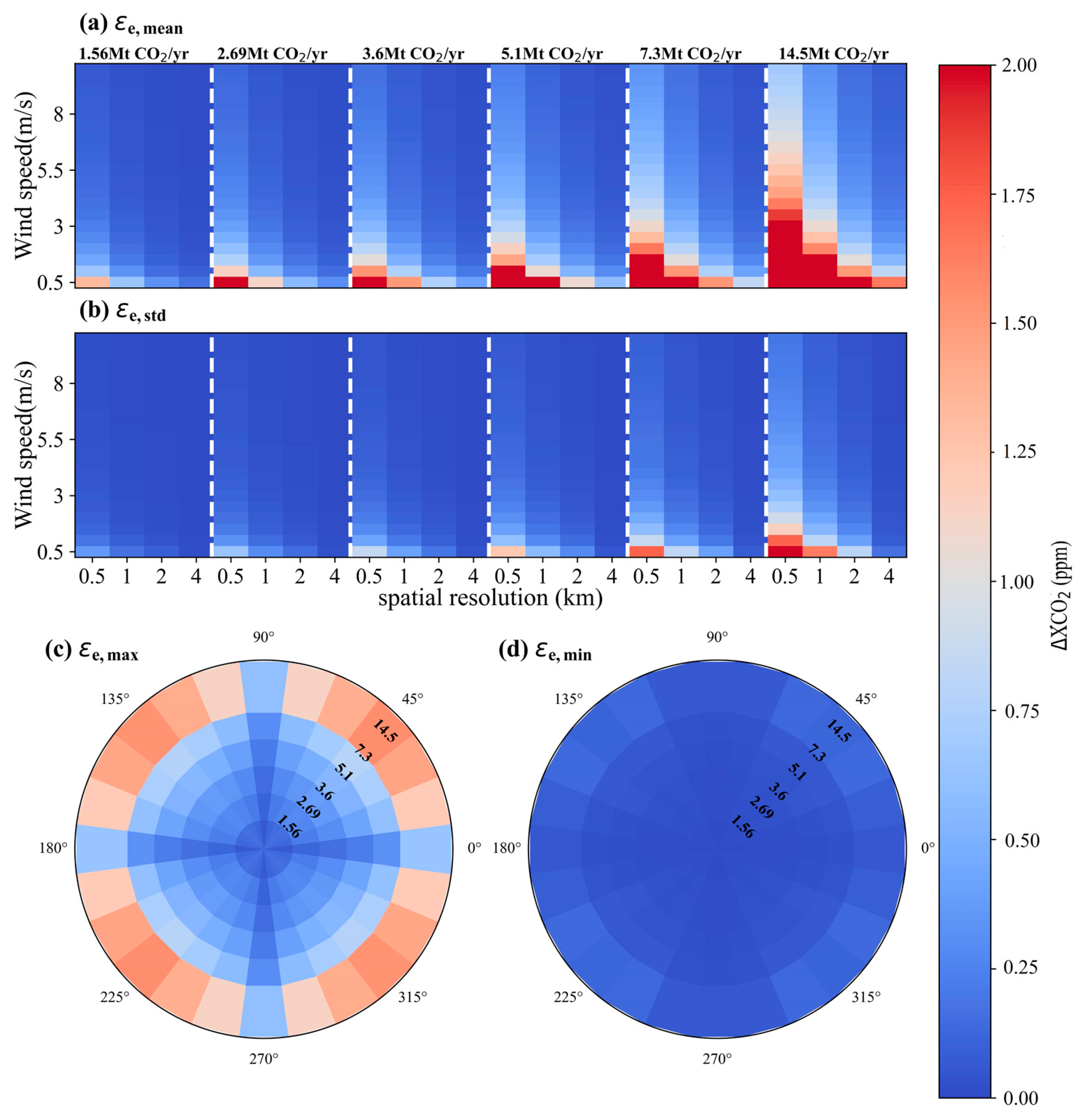


Disclaimer/Publisher’s Note: The statements, opinions and data contained in all publications are solely those of the individual author(s) and contributor(s) and not of MDPI and/or the editor(s). MDPI and/or the editor(s) disclaim responsibility for any injury to people or property resulting from any ideas, methods, instructions or products referred to in the content. |
© 2024 by the authors. Licensee MDPI, Basel, Switzerland. This article is an open access article distributed under the terms and conditions of the Creative Commons Attribution (CC BY) license (https://creativecommons.org/licenses/by/4.0/).
Share and Cite
Li, Z.; Fan, M.; Tao, J.; Xu, B. Impacts of Spatial Resolution and XCO2 Precision on Satellite Capability for CO2 Plumes Detection. Sensors 2024, 24, 1881. https://doi.org/10.3390/s24061881
Li Z, Fan M, Tao J, Xu B. Impacts of Spatial Resolution and XCO2 Precision on Satellite Capability for CO2 Plumes Detection. Sensors. 2024; 24(6):1881. https://doi.org/10.3390/s24061881
Chicago/Turabian StyleLi, Zhongbin, Meng Fan, Jinhua Tao, and Benben Xu. 2024. "Impacts of Spatial Resolution and XCO2 Precision on Satellite Capability for CO2 Plumes Detection" Sensors 24, no. 6: 1881. https://doi.org/10.3390/s24061881
APA StyleLi, Z., Fan, M., Tao, J., & Xu, B. (2024). Impacts of Spatial Resolution and XCO2 Precision on Satellite Capability for CO2 Plumes Detection. Sensors, 24(6), 1881. https://doi.org/10.3390/s24061881






